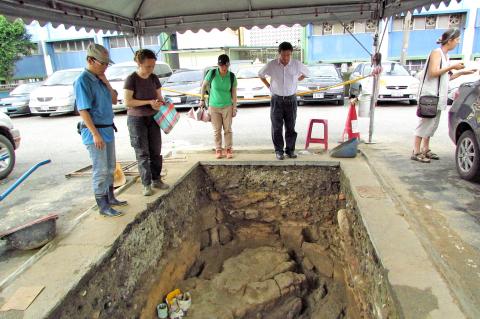An archeology team has uncovered the foundations of a Spanish chapel on an island off northern Taiwan.
Scientists said that it is an important discovery which sheds light on the history of the European colonial era during the 17th century.
The chapel was part of the Fort San Salvador complex on Heping Island (和平島) in a strategic position at the mouth of Keelung harbor and was built by the Spanish during their brief occupation of northern Taiwan more than 300 years ago.

Photo: Lu Hsien-hsiu, Taipei Times
The excavation is an international collaboration between the Academia Sinica, headed by project leader Tsang Cheng-hwa (臧振華), and an archeological research team from Spain.
Tsang, a research fellow at Academia Sinica’s Institute of History and Philology, said three corners of the chapel’s foundations were uncovered at the dig, which is taking place at a parking lot on the island.
He added that skeletal remains of two males were found at the site, one complete skeleton and another which was incomplete. The remains were judged to be contemporaneous with the fort complex.
“Right now we are not sure if the remains belong to the Spanish, or the Formosan Aborigines who were the main inhabitants of the northern coast during that time. So DNA tests will be conducted to determine their origin... It could turn out that these are the oldest evidence of the Spanish occupation yet found in Taiwan,” Tsang said.
Tsang said the dig enabled the team to determine the exact location of the chapel and it correlates with the position shown on maps of the period.
The team found that the Spanish garrison used materials they found on the island to build the chapel, as a section of the wall matched rocks found in nearby hills.
When excavating deeper around the chapel site, the team dug up much older archeological relics dating back to 2,500 to 3,000 years ago, including stone tools, pottery pieces and decorative items made from Taiwanese jade.
“This indicated that ancient civilizations were active on Heping Island and in the whole northern coastal area more than 3,000 years ago. Due to these recent finds, we will expand our excavation efforts around Fort San Salvador in the coming years, because these are important Taiwanese cultural treasures,” Tsang said.
The fort was a key stronghold during the brief Spanish occupation of northern Taiwan in the 17th century.
In 1626, Spain dispatched a fleet of warships from Manila, and sailed to Quelang — the old name for Keelung — as the fort was built that year.
For its defensive fortifications and firepower, at one time Fort San Salvador had 27 copper cannons and six iron cannons, according to Spanish documents.
After some years of battling for trade concessions and colonial holdings, in 1642 Spain ceded the fort to the Dutch, who renamed it Fort Noord-Holland.

Chinese Nationalist Party (KMT) Chairman Eric Chu (朱立倫), spokeswoman Yang Chih-yu (楊智伃) and Legislator Hsieh Lung-chieh (謝龍介) would be summoned by police for questioning for leading an illegal assembly on Thursday evening last week, Minister of the Interior Liu Shyh-fang (劉世芳) said today. The three KMT officials led an assembly outside the Taipei City Prosecutors’ Office, a restricted area where public assembly is not allowed, protesting the questioning of several KMT staff and searches of KMT headquarters and offices in a recall petition forgery case. Chu, Yang and Hsieh are all suspected of contravening the Assembly and Parade Act (集會遊行法) by holding

PRAISE: Japanese visitor Takashi Kubota said the Taiwanese temple architecture images showcased in the AI Art Gallery were the most impressive displays he saw Taiwan does not have an official pavilion at the World Expo in Osaka, Japan, because of its diplomatic predicament, but the government-backed Tech World pavilion is drawing interest with its unique recreations of works by Taiwanese artists. The pavilion features an artificial intelligence (AI)-based art gallery showcasing works of famous Taiwanese artists from the Japanese colonial period using innovative technologies. Among its main simulated displays are Eastern gouache paintings by Chen Chin (陳進), Lin Yu-shan (林玉山) and Kuo Hsueh-hu (郭雪湖), who were the three young Taiwanese painters selected for the East Asian Painting exhibition in 1927. Gouache is a water-based

Taiwan would welcome the return of Honduras as a diplomatic ally if its next president decides to make such a move, Minister of Foreign Affairs Lin Chia-lung (林佳龍) said yesterday. “Of course, we would welcome Honduras if they want to restore diplomatic ties with Taiwan after their elections,” Lin said at a meeting of the legislature’s Foreign Affairs and National Defense Committee, when asked to comment on statements made by two of the three Honduran presidential candidates during the presidential campaign in the Central American country. Taiwan is paying close attention to the region as a whole in the wake of a

OFF-TARGET: More than 30,000 participants were expected to take part in the Games next month, but only 6,550 foreign and 19,400 Taiwanese athletes have registered Taipei city councilors yesterday blasted the organizers of next month’s World Masters Games over sudden timetable and venue changes, which they said have caused thousands of participants to back out of the international sporting event, among other organizational issues. They also cited visa delays and political interference by China as reasons many foreign athletes are requesting refunds for the event, to be held from May 17 to 30. Jointly organized by the Taipei and New Taipei City governments, the games have been rocked by numerous controversies since preparations began in 2020. Taipei City Councilor Lin Yen-feng (林延鳳) said yesterday that new measures by